Coral fountain (
Russelia equisetiformis), with its drought tolerance, unique natural shape and coral-red blooms that attract hummingbirds from spring through fall, is quickly growing more popular in landscapes, where its soft, rounded growth habit and finely textured foliage add welcome contrast against more formal plantings.
While this Mexican native can take over in tropical climates such as Florida, it finds a welcome home in the drier climates throughout California, Texas and the Southwest, where its growth is checked by the availability of water. Its needs are few, whether grown in the ground or in a container; it thrives in sun or partial shade while adding beauty to the water-wise garden.
Caution: Avoid planting coral fountain in areas with a hot, humid climate, like Florida and the Southeast, where it can become invasive.
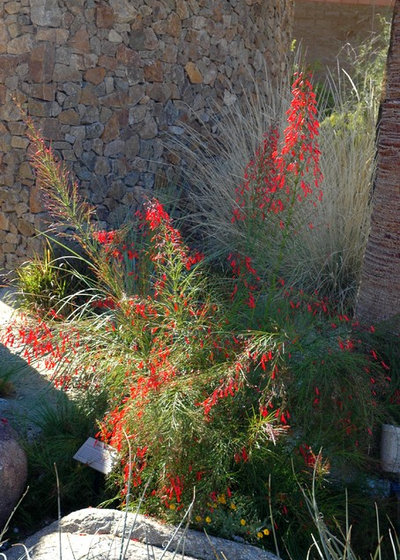
Noelle Johnson Landscape Consulting
Botanical name: Russelia equisetiformisCommon names: Coral fountain, firecracker plant, coral plant
Origin: Native to Mexico
Where it will grow: Hardy to 15 degrees Fahrenheit (USDA zone 8; find your zone)
Water requirement: Drought tolerant once established but does best when watered weekly in summer and every 10 days in spring and fall; water twice a month in winter
Light requirement: Full sun or partial shade; avoid areas that receive hot, reflected sun
Mature size: 3 to 4 feet tall and 4 to 5 feet wide
Benefits and tolerances: Drought tolerant; attracts hummingbirds
Seasonal interest: Flowers in spring, summer and fall; blooms can appear in winter in frost-free areas
When to plant: In spring from transplants
Shown: Coral fountain growing at The Living Desert Zoo & Gardens in Palm Desert, California
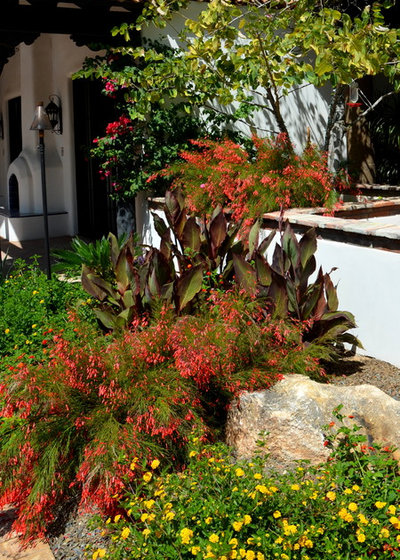
Noelle Johnson Landscape Consulting
Distinguishing traits. The feathery, cascading foliage resembles a flowing fountain, hence its common name. The foliage is made up of bright green stems that are mostly leafless. Any leaves that do appear are small and scale-like in appearance.
While it is frost tender when temperatures dip below freezing, regrowth is rapid in zones 8 and above. Pruning in spring, after the last frost date, is all that is needed for this low-maintenance plant. For those who live in colder zones, coral fountain can be brought inside to overwinter by a sunny window. Avoid any efforts to formally shape coral fountain — the results won’t look attractive, and its natural shape will soon reassert itself.
Shown: ‘New Gold’ lantana (
Lantana ‘New Gold’) and canna lilies (
Canna sp) make great companions for coral fountain.
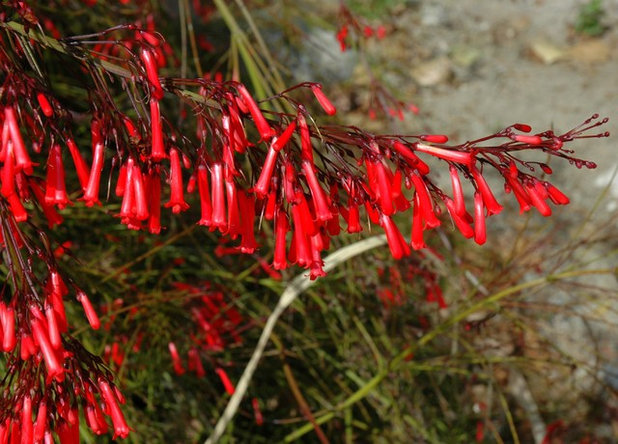
Noelle Johnson Landscape Consulting
The 1-inch flowers of this shrubby perennial may be small, but what they lack in size, they make up for in sheer volume, packing a powerful color punch in the landscape. While the majority of blooms appear from spring through fall, flowers can continue through the winter in frost-free climates. Hummingbirds are sure to be found nearby wherever coral fountain is planted.
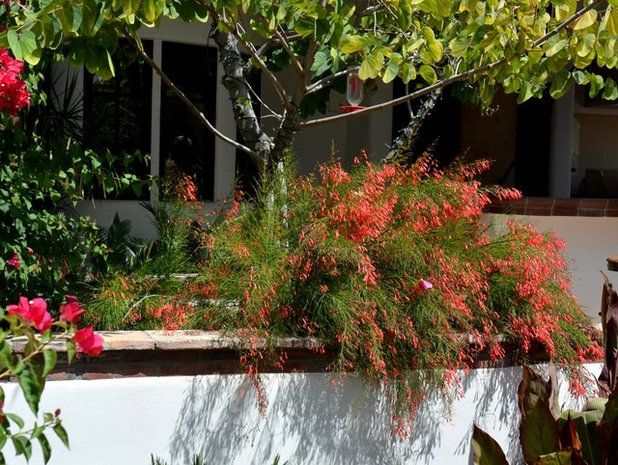
Noelle Johnson Landscape Consulting
How to use it. The unique cascading growth habit of coral fountain makes it a great choice for landscapes where plants are allowed to grow into their natural shapes. However, it can also be used in more formal landscapes, where its cascading, finely textured foliage can offer contrast against more formally shaped trees and shrubs.
Coral fountain is a great choice for areas next to swimming pools, water features or in raised beds, where its foliage can spill over for a nice decorative effect.
Plant it in groups of three or five in the filtered shade underneath palo blanco (
Acacia willardiana) or palo verde (
Parkinsonia x ‘Desert Museum’) trees for a cascading carpet of green and coral-red colors.
For great color contrast, plant it alongside blackfoot daisy (
Melampodium leucanthum), golden barrel cactus (
Echinocactus grusonii), ‘New Gold’ lantana
or desert ruellia (
Ruellia peninsularis).
For dramatic color and texture contrast, mix it with gray agave species, such as
Agave americana.
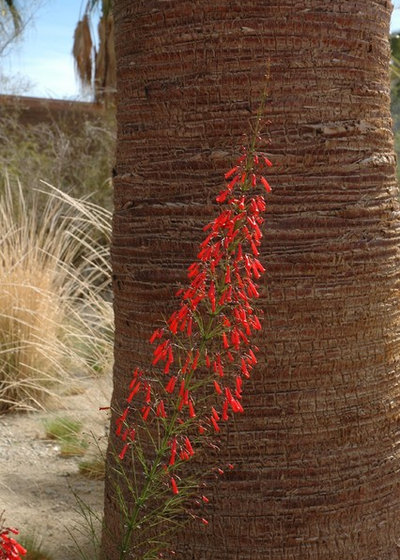
Noelle Johnson Landscape Consulting
Planting notes. Dig a hole three times as wide as the root ball, but keep the depth the same as the root ball. Add compost to the native soil at a ratio of 1:1 before planting. If you’re growing it in a container, use a planting mix specially formulated for containers.
Select a location that receives full sun or filtered sun. Avoid locations with reflected sun or heavy shade. Apply a slow-release fertilizer in spring for best results.
More:Attract Hummingbirds and Bees With These Beautiful Summer Flowers
Learn more about gardening with native plants in your area





